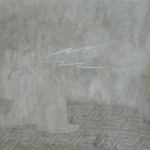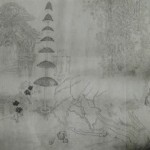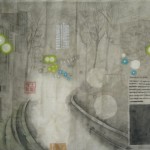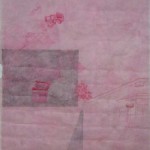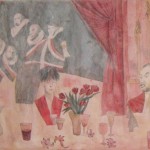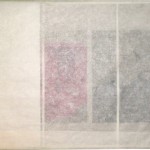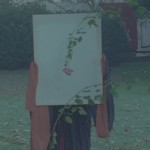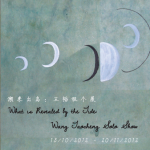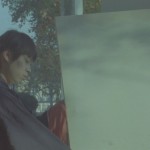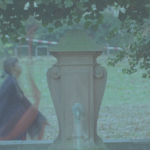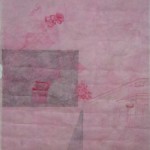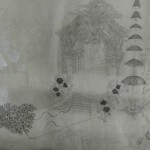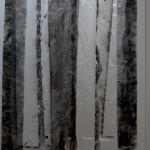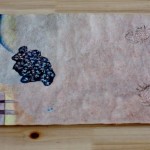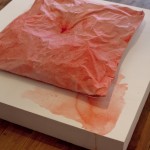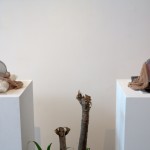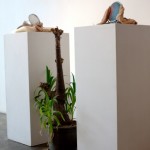What is Revealed by the Tide: Wang Taocheng Solo Show: Artist Statements
October 13th, 2012 - November 20th, 2012
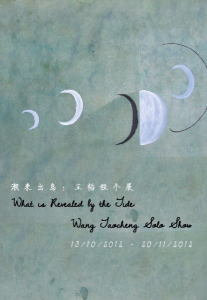
Wang Taocheng: What is Revealed by the Tide No.2,ink, watercolor, mineral pigment, tea water, gold powder, xuan paper, 520 x 33 cm, 2012
1. The right door of the Dashuif a building on the construction blueprint of the Summer Palace.
2. The entrance to Amsterdam’s Oosterpark.
3. The baroque costumes from the movie Orlando, directed by Sally Potter.
4. Plants in at the Nizza Riverside Garden in Frankfurt.
5. The first part of “Spring Morning in the Han Palace,” painted by Qiu Ying in the Ming Dynasty
6. The lyrics of Angus Tung’s song “Never Forget.”
7. “Der Raeuber Und Der Prinz,” a song by German electropunk band D.A.F – Deutsch
Amerikanische Freundschaft.
8. A headdress of the highest-ranking imperial concubine of the Qing Dynasty.
9. Costumes of the nomadic people of the Qing Dynasty.
10.The interior of the Russian Winter Palace.
11. Costumes from the British TV series “Downtown Abbey.”
12. A scene from the old TV series “Lightning Goddess.”
Wang Taocheng: What is Revealed by the Tide No.1,ink, watercolor, mineral pigment, tea water, gold powder, xuan paper, 520 x 33 cm, 2012
1. This topic comes from the introductory music in Ang Lee’s film “Lust, Caution.”
2. Paris Fashion Week - A/W 2012-2013 fashion show by Dior's new designer Raf Simons.
The space featured a tiled floor and a baroque-style fireplace. The fashion show was luxuriant,
morbid, reserved, conservative and also very avant-garde. It is certainly worth a look.
3. The arabesque decorative pattern from the qipaos, worn by Tang Wei in the film “Lust,
Caution,” and the grains represent the grains of color on a TV screen.
4. The cover design of a Joy Division album.
5. The costumes from the video of the single “Genesis” by the 90s Canadian band Grimes.
6. In the end of the old TV series “Butterfly Sword” with Yang Ziqiong, there is a scene where
Eunuch Cao has his head kicked off and his headless body holds onto a pillar in the ruined
palace while bricks and clothing dance in an abstract way.
7. The design and construction blueprint for the “Xian Fa Hua,” “Xie Qiqu” and “Hai Yan Tang”
areas of the Old Summer Palace (just like the fountains in the picture) and its copperplate
painting style.
8. The Palace of Fontainebleau in France, the Palace of Versailles, the facade of the Frankfurt
Stock Exchange building, the interior of the Sacred Heart Cathedral in Paris, vases from the
Netherlands and selections of Qing Dynasty costumes from the 19th century.
9. A verse from “Dream of the Red Chambers,” which features a line about the character Xi Ren:
“When the aroma comes to you, the weather suddenly gets warm.”
10. A text about an old Buddhist nun who asks Wang Xifeng for help in “A Dream of Red
Mansions.” I added in some things and made some revisions to it.
11. Lyrics from Xu Xiaofeng's old songs.
12. In the novel “The Makioka Sisters,” there is a neurotic little girl from a noble family named
Etsuko who says: “Whatever I say is right and everyone else is wrong. Why do I have to
apologize?”
Wang Taocheng: Still Lifes: Wild Ducks and Swans Arrive in Frankfurt,ink, watercolor, mineral pigment, tea water, gold powder, xuan paper, 356 x 33 cm, 2012
This work is still about my life in Frankfurt, and it describes my terribly depressing life there through landscapes and still lifes. The work takes the local landscape as its focus and depicts the flood of the River Main in 2011, where swans floated slowly and elegantly down the street.
The work also incorporates still lifes from the kitchen table in my apartment. I chose this painting format because of something I learned in a recent art class, a kind of paradox of artworks. It doesn’t matter how you create something, you can never separate yourself from the materials - their literary connotations and background stories. Especially being an artist, there is no way for you to escape the process of employing references and interpreting works. Good works almost always involve classical references and encyclopedic wisdom combined with a political fervor.
Although the advantages of changing points of view and lateral thinking are inherent in the process of creation, they can also become disadvantages. In my mind, the most independent things are still lifes and landscapes. Figures are comparably independent, that is to say, figures are not as cold as the former. So the things in the painting are quite showy, but also empty at the same time.
The work is divided into three parts. The content of the painting is very figurative. For instance, for the still life section of the first part (from right to left), I intentionally employed a realistic commercial cartoon style to create a not fully realized feeling of depression. This reminds me of the flowers in my apartment. It doesn’t matter where my roommate puts them; there is always something wrong with the atmosphere. Maybe this is because two people once died in my apartment. To put it in local parlance, there is bad “fengshui.” It’s a haunted house. At the same time it hints that at something my Chinese friends and I experience in Frankfurt: terrible dreams during the full moon - something we never experience in China. The moon seen from China always contains a sense of historic beauty, but still lacks the ability to bring us comfort.
Wang Taocheng: Frankfurt Fireworks in 5 Parts,ink, watercolor, mineral pigment, tea water, gold powder, xuan paper, 477 x 33 cm, 2012
1. I created this five-part image according to a blueprint in my memory of seeing fireworks five
times in Frankfurt in early 2012.
2. I was inspired by the abstract video series “Untitled” shown at the Gloria Cinema at the 13th
Documenta by a young American artist Trisha Donnelly.
Wang Taocheng: "Practice of Portraits," Op.55,Acrylic color, mineral color, tea, pencil, A4 paper, on rice paper
“A lone railing: tears are thriving. Even without her makeup, she still has the same poise. Night rain falls behind the closed door; inside there is the melancholic void of her thoughts, like a golden wave slowly fading into darkness.”
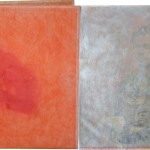

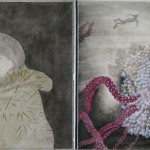
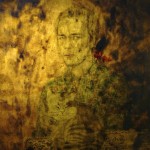
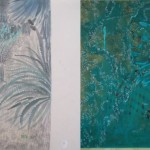
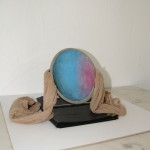

529.5x33cm_2-150x150.jpg)
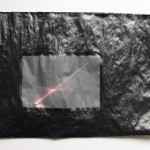
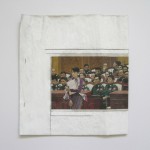
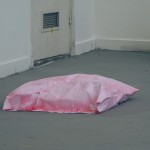
529.5x33cm-150x48.jpg)
